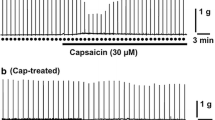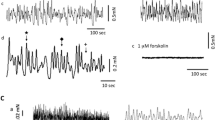Summary
Non-cholinergic, non-adrenergic responses to nerve stimulation recorded from smooth muscles of the guinea-pig duodenum, jejunum, proximal and terminal ileum were investigated in an attempt to characterize these responses.
In the presence of atropine (1–2 μmol · l−1) and guanethidine (10 μmol · l−1) coaxial stimulation induced in all regions of the guinea-pig small intestine an initial relaxation (primary relaxation) upon which contraction (primary contraction) appeared, followed by rebound contraction.
Noradrenaline decreased the cholinergic smooth muscle twitches, predominantly at low stimulation frequencies, and had a similar effect on the non-cholinergic, non-adrenergic primary relaxation, primary and rebound contractions.
ATP decreased the smooth muscle twitches; however, this agent had only a transient influence on the non-cholinergic, non-adrenergic responses of muscle (tension and membrane potential) to single stimuli. With higher stimulus frequencies ATP increased the primary relaxation and decreased the contraction phases. ATP also inhibited the post-tetanic inhibition induced by non-cholinergic, non-adrenergic nerve stimulation.
In most of the muscle cells of the guinea-pig proximal and terminal ileum the non-cholinergic, non-adrenergic nerve stimulation generated i.j.p.s., while about 15–20% of the cells responded with e.j.p.s. During long-lasting stimulation (10s) the i.j.p.s. were sometimes “interrupted” by action potentials or by a gradual depolarization of the membrane. The i.j.p.s. were followed by a marked rebound depolarization accompanying the action potentials. Those cells which generated i.j.p.s. in response to field stimulation, were depolarized by ATP, while those cells, which generated e.j.p.s, were hyperpolarized by ATP.
A reduction in the concentration of extracellular sodium chloride decreased both the primary and rebound contractions; the primary contraction was, however, more sensitive than was the rebound contraction.
Theophylline increased the primary and rebound contractions with no marked influence on the primary relaxation, lowered the action potential threshold, increased the rebound depolarization and did not markedly influence the i.j.p.s.
Quinidine enhanced the primary relaxation and inhibited the primary contraction in a concentration-dependent manner. Inhibition of the rebound contraction by quinidine was slight (less than 50%).
The present results demonstrate that primary relaxation, primary and rebound contractions are associated with i.j.p.s and e.j.p.s., and rebound depolarization with action potentials, respectively; they are typical responses of various regions of the guinea-pig small intestine to activation of inhibitory and excitatory non-cholinergic, non-adrenergic nerves. The P1 and P2 receptors, proposed by Burnstock (1975), probably do not mediate the non-cholinergic, non-adrenergic postsynaptic responses of the guinea-pig small intestine. A possible physiological function of ATP as a mediator of non-cholinergic, non-adrenergic nerves of the guinea-pig small intestine is discussed.
Similar content being viewed by others
References
Ambache N, Freeman MA (1968) Atropine-resistant longitudinal muscle spasms due to excitation of non-cholinergic neurones in Auerbach's plexus. J Physiol (Lond) 199:705–728
Ambache N, Verney J, Zar MA (1970) Evidence for the release of two atropine-resistant spasmogens from Auerbach's plexus. J Physiol (Lond) 207:761–782
Baer HP, Frew R (1979) Relaxation of guinea-pig fundic strip by adenosine, adenosine triphosphate and electrical stimulation: lack of antagonism by theophylline or ATP treatment. Br J Pharmacol 67:293–299
Bauer V (1981) Distribution and types of adrenoceptors in the guinea-pig ileum: the action of α- and β-adrenoceptor agonists. Br J Pharmacol 72:201–210
Bennett MR, Burnstock G, Holman ME (1966) Transmission from intramural inhibitory nerves to the smooth muscle of the guinea-pig taenia coli. J Physiol (Lond) 182:541–558
Bowman WC, Hall MT (1970) Inhibition of rabbit intestine mediated by α- and β-adrenoceptors. Br J Pharmacol 38:399–415
Bülbring E, Tomita T (1967) Properties of inhibitory potential of smooth muscle as observed in the response to field stimulation of the guinea-pig taenia coli. J Physiol (Lond) 189:299–316
Burnstock G (1971) Neural nomenclature. Nature 229:282–283
Burnstock G (1975) Purinergic transmission. In: Iversen LL, Iversen SD, Snyder SH (eds) Handbook of Psychopharmacology 5:131–194
Burnstock G (1978) A basis for distinguishing two types of purinergic receptor In: Straub RW, Bolis L (eds) Cell membrane receptors for drugs and hormones. Raven Press, New York, pp 107–118
Burnstock G, Campbell G, Satchell DG, Smythe A (1970) Evidence that adenosine triphosphate or a related nucleotide is the transmitter substance released by non-adrenergic inhibitory nerves in the gut. Br J Pharmacol 40:668–688
Burnstock G, Satchell DG, Smythe A (1972) A comparison of the excitatory and inhibitory effects of non-adrenergic, non-cholinergic nerve stimulation and exogenously applied ATP on a variety of smooth muscle preparations from different vertebrate species. Br J Pharmacol 46:234–242
Campbell G (1971) Autonomic innervation of the lung musculature of a toad (Bufo marinus). Comp Gen Pharmacol 2:281–285
Delaunois AL (1973) Biostatistics in pharmacology. Pergamon Press, Oxford, pp 675–738
Furness JB (1969) An electrophysiological study of the innervation of the smooth muscle of the colon. J Physiol (Lond) 205:549–562
Furness JB (1971) Secondary excitation of intestinal smooth muscle. Br J Pharmacol 41:213–226
Hirst CDS, Neild TO (1980) Evidence for two populations of excitatory receptors for noradrenaline on arteriolar smooth muscle. Nature 283:767–768
Kadlec O, Mašek K, Šeferna I (1979) Post-tetanic potentiation in the innervated smooth muscle preparation of the guinea-pig ileum. Eur J Pharmacol 60:383–386
Kosterlitz HW, Watt AJ (1963) Reflex contractions of the longitudinal muscle of isolated guinea-pig ileum resistant to the inhibitory action of morphine and hyoscine. J Physiol (Lond) 169:115–116
Kosterlitz HW, Lydon RJ (1969) Spontaneous electrical activity and nerve-mediated inhibition in the innervated longitudinal muscle strip of the guinea-pig ileum. J Physiol (Lond) 200:126–128
Kosterlitz HW, Lord JAH, Watt AJ (1973) Morphine receptor in the myenteric plexus of the guinea-pig ileum. In: Kosterlitz HW, Collier HOJ, Villarreal JE (eds) Agonist and antagonist actions of narcotic analgesic drugs. University Park Press, Baltimore, pp 45
Kuriyama H, Osa T, Toida N (1967) Nervous factors influencing the membrane activity of intestinal smooth muscle. J Physiol (Lond) 191:257–270
McIlwain H (1972) Regulatory significance of the release and action of adenine derivatives in cerebral system. Biochem Soc Symp 36:69–85
Okwusaba FK, Hamilton JT, Cook MA (1977) Relaxation of guinea-pig fundic strip by adenosine, adenine nucleotides and electrical stimulation: antagonism by theophylline and desensitization to adenosine and its derivatives. Eur J Pharmacol 46:181–198
Paton DM (1979) Presynaptic inhibition of adrenergic neurotransmission by adenine nucleotides and adenosine. In: Baer HP, Drummond GJ (eds) Physiological and regulatory functions of adenosine and adenine nucleotides. Raven Press, New York, N4, pp 69–78
Paton WDM (1955) The response of the guinea-pig ileum to electrical stimulation by coaxial electrodes. J Physiol (Lond) 127:40–41P
Paton WDM, Vizi ES (1969) The inhibitory action of noradrenaline and adrenaline on acetylcholine output by guinea-pig ileum longitudinal muscle strip. Br J Pharmacol 35:10–28
Ribeiro JA (1979) Purinergic modulation of transmitter release. J Theor Biol 80:259–270
Starke K, Endo T, Taube HD (1975) Relative pre- and postsynaptic potencies of α-adrenoceptor agonists in the rabbit pulmonary artery. Naunyn-Schmiedeberg's Arch Pharmacol 291:55–78
Suzuki H, Kuriyama H (1975) Electrical and mechanical properties of longitudinal and circular muscles of the guinea-pig ileum. Jpn J Physiol 25:759–773
Vizi ES, Knoll J (1976) The inhibitory effect of adenosine and related nucleotides on the release of acetylcholine. Neuroscience 1:391–398
Author information
Authors and Affiliations
Additional information
This study was supported in part by JSPS Japan
Rights and permissions
About this article
Cite this article
Bauer, V., Matušák, O. & Kuriyama, H. Non-cholinergic, non-adrenergic responses to nerve stimulation of different regions of the guinea-pig small intestine. Naunyn-Schmiedeberg's Arch. Pharmacol. 319, 108–114 (1982). https://doi.org/10.1007/BF00503921
Received:
Issue Date:
DOI: https://doi.org/10.1007/BF00503921




